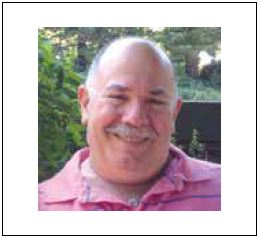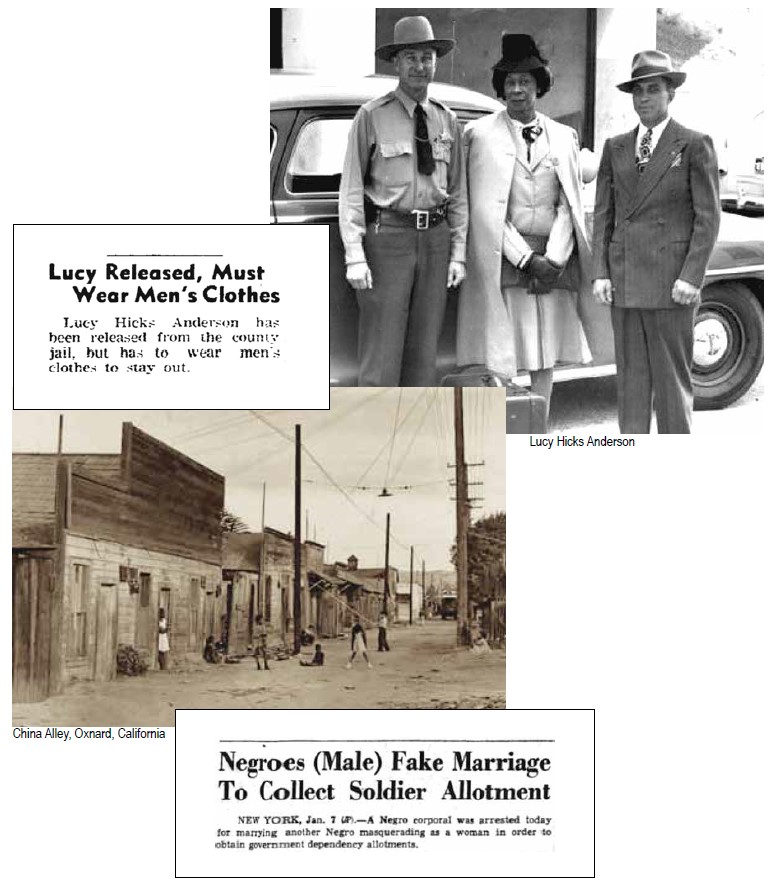
By Dr. Bill Lipsky–
Between the World Wars, the small farming community of Oxnard, California, was home to a remarkable woman. Described by the local press as “a six-feet-tall, skinny, very stylish raw-bone Negress,” she was a prize-winning cook, nanny, and society hostess beloved by the town’s most influential residents, who did not know or care that she also ran a successful bawdy house—or that she began her life identified as a male. She was Mrs. Lucy Hicks, who insisted on being herself always.
Lucy was born in 1886 to former slaves William and Nancy (Webb) Lawson in rural Kentucky. Named Tobias, but called “Toby” or “Tossie” by family and friends, at first the youngster was raised as a boy. When still “a very young child,” however, her mother became concerned that her son “would only dress in girls’ clothing.” At nine years old, they went to see “Dr. Jesse,” who told them, Lucy explained later, “I was more of a girl than a boy.”
During his examination, the good doctor may have noticed essential qualities of both genders in the child. Whatever his diagnosis and however he explained it, Nancy apparently accepted the information with grace and understanding. “There’s nothing to do,” she said. “You’re a girl and you’re not like other little girls.” She began raising Tossie as a daughter, calling her “Lucy.” For the rest of her life, Lucy lived as a woman and fought for her right to be who she was.
We know very little for certain about Lucy’s life during the next 25 years. At some point she left Kentucky, worked for a while in a hotel in Texas, then moved to New Mexico, where she married Clarence Hicks in 1920. Apparently, the couple maintained a virtuous relationship before their honeymoon, because the groom was unaware that, among her other attributes, his “’bride’ was rather peculiar in that ‘she shaved every day.'”

After their wedding, Mr. and Mrs. Hicks travelled to Los Angeles, where Clarence went to the local police complaining that “his ‘bride’ was acting suspiciously.” During questioning, Lucy allegedly “confessed to being a man.” Clarence left her immediately, although he never filed for divorce. Lucy moved to Oxnard, 60 miles north, where she quickly became known for her wizardry in the kitchen. She finally filed divorce papers in 1929. No one questioned her gender.
Eventually Lucy bought an old boarding house at the corner of 7th and B Street, near Oxnard’s notorious China Alley, which she promptly turned into a speakeasy and brothel. Successful immediately, she eventually expanded “into a half-block of frame buildings, each well furnished, neatly painted and with window boxes full of geraniums.” Both her businesses were illegal, but local authorities were interested only in her illicit sale of alcohol.
Mrs. Hicks twice faced charges for violations of the Volstead Act. In 1927, she was convicted for possessing liquor and paid a $200 fine, but spent no time behind bars. In 1928, however, after a jury found her guilty on three counts of selling alcoholic beverages, she spent 45 days in the woman’s wing of the county jail. Although her brothel was intimately connected to her speakeasy, no one mentioned it; she continued to run it for another 17 years.
Lucy married again in 1944. Reuben Anderson, born in 1911, worked at Bullock’s department store in Los Angeles before joining the Army in 1942; by the time the war had ended, he’d risen to the rank of corporal. No one knows how he reacted when he learned that his wife legally would be considered a man 26 years older than himself—those may have been among her many qualities that charmed him—but they remained a couple for the rest of her life.
In 1945, when the military began investigating an outbreak of venereal disease among local servicemen, authorities ordered that all of the women at Lucy’s brothel undergo a medical examination, including Lucy. She objected. She never worked as a prostitute, she said, so no evaluation was necessary. Overruled, a panel of five physicians then reported that Lucy biologically was a male.
Having been denied her identify, Lucy faced serious felony charges of perjury for “falsely claiming to be a woman on her marriage license.” At her trial, she challenged the authority of the physicians who insisted that she was male. “I defy any doctor in the world to prove that I am not a woman,” she said. “I have lived, dressed, acted just like what I am, a woman.” A jury still convicted her, but her judge sentenced her to ten years of probation only.
Now legally a man, Lucy learned that the federal government was investigating her for “failing to register” for the draft and, no longer lawfully married, for “fraudulently accepting” allowance checks that were meant for the wives of servicemen. Eventually, the first case was dropped, but she stood trial in the second. A gynecologist testified that “the Oxnard Negro could be of dual sex” because she had “both female and male characteristics, with the female predominant,” but the jury was unpersuaded.
The prosecuting attorney concluded his case with a familiar argument: “Does the jury wish to allow Hicks to continue to live as a woman, to violate the sanctity of homes, to associate with women in rest rooms?” The court sentenced Lucy to one year in jail and ten years on probation. During that time, she could not return to Oxnard for any reason. Reuben, tried separately, also was convicted of fraud. At the end of their terms, they moved to Los Angeles, where Lucy died in 1954.
Unlike many people before her and since, Lucy knew who she was from an early age. Despite the concerted efforts of so-called medical experts and well-meaning jurists, unaware of the infinite variety in human sexuality, she never wavered from her understanding of her true self. No social, cultural, or even legal expectations could force her into being anyone but who she was. “I shall die a woman,” she told the court during one of her trials. Indeed, she did.
Bill Lipsky, Ph.D., author of “Gay and Lesbian San Francisco” (2006), is a member of the Rainbow Honor Walk board of directors.
Published on October 7, 2021
Recent Comments